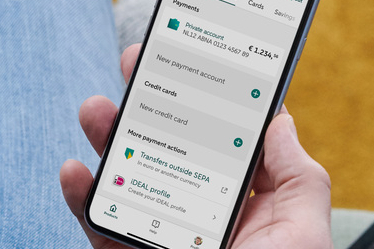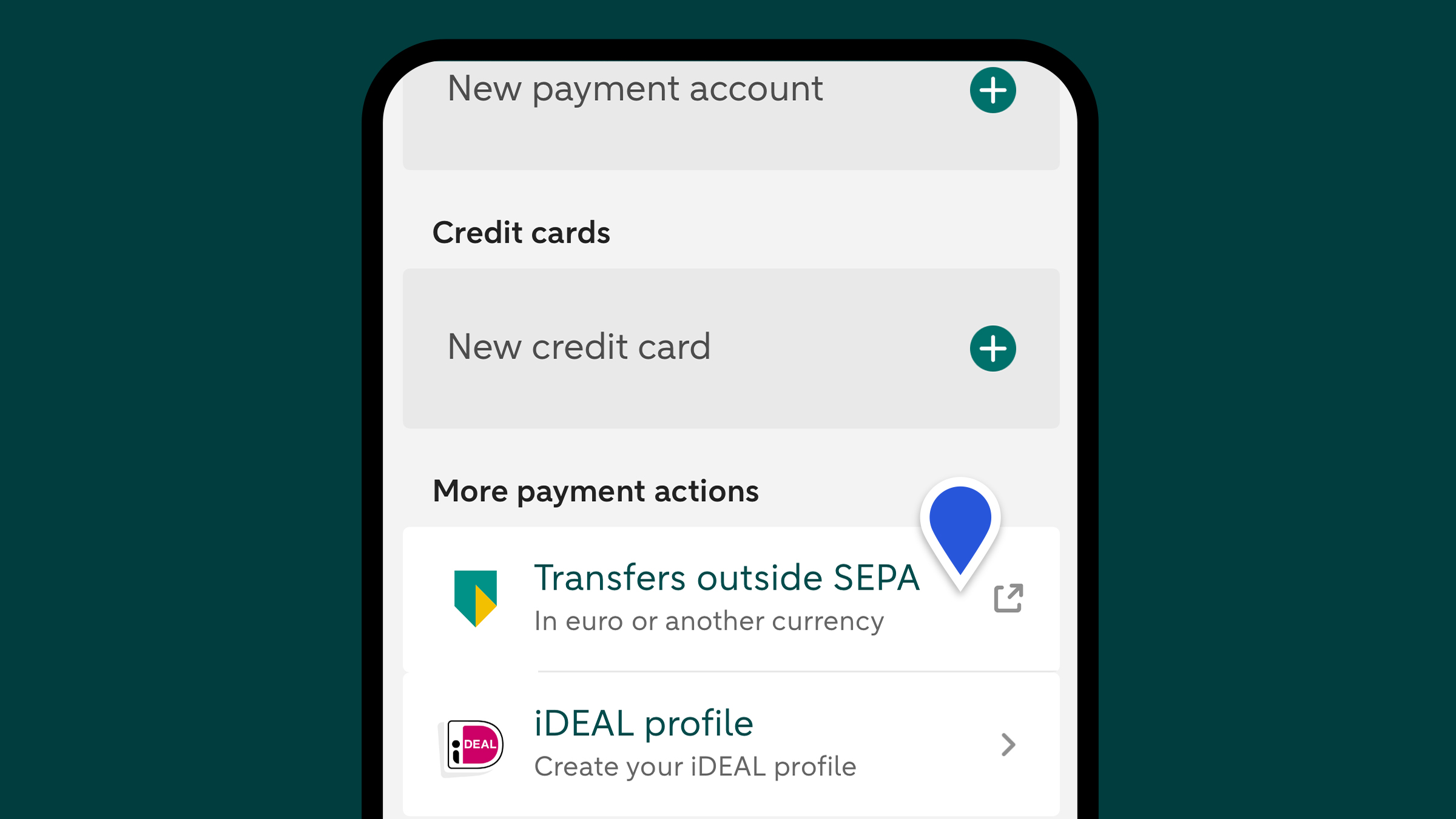
Transferring money abroad
Here’s how it’s done
Transferring money abroad? You can easily do this using Internet Banking or the ABN AMRO app, depending on whether your transfer is to a SEPA country and whether it's in euros or another currency. Read all about transferring money abroad and how it’s done.

Check if the country is a SEPA country
First check if the country you want to transfer money to is a
SEPA country
and decide whether you want to make the transfer in euros or another currency (if the country has a currency other than the euro). Then, read below how you can easily make an international transfer.Transferring money to
SEPA country in euros

It’s just as easy as making a transfer within the Netherlands. You can do it in your ABN AMRO app or on Internet Banking.
SEPA country in foreign currency or a country outside SEPA

Whether your transfer is in another currency, or to a country outside SEPA: you can easily do this in the ABN AMRO app, or on Internet Banking.

What it costs
Whether, and if so how much, you will be charged depends on whether you are transferring euros or another currency, on whether the country to which you are transferring money is a SEPA country, and on other factors. We have put together a convenient overview for you, so that you know exactly what you will be charged.
Step-by-step instructions and guidelines
Step-by-step instructions for foreign currency transfers and/or outside of the SEPA
Step-by-step instructions for foreign currency transfers and/or to countries outside of the SEPA.
If you want to transfer money in a currency other than the euro and/or to a country outside of the SEPA, take a look at the guidelines for the relevant country first to see if there are special rules for that country. These rules may affect your transfer. Once you’ve checked this, follow the step-by-step instructions below.
- Open the ABN AMRO app and log in.
- Select 'Transfers outside SEPA' on the Payments tab.
- You will now automatically go to Internet Banking, select the account from which you want to send the international transfer.
- Select ‘New transfer’.
- Select the currency of the recipient’s country and enter the amount you want to transfer. You can also select ‘euro’ here.
- Select the recipient’s country and enter the required details. It is also indicated per country whether you must enter a BIC and/or a BCC.
- Choose whether to share the fees, pay them yourself, or have the recipient pay them.
- Click ‘Send now’ and confirm using the ABN AMRO app or one of our other tools.
You have now made a transfer to a foreign account.
Country-specific guidelines
Some countries have different rules. In order to make sure your transfer arrives correctly, we have compiled guidelines for the countries listed below. If the country to which you want to transfer money is not listed, there are no special guidelines for that country.
Restricted countries
Restrictions apply for transfers to certain countries, which means that transfers are not possible, or are processed with a delay. The restrictions may be imposed by the Dutch government, by a different country, by us or by another bank. Find out more about why this is and which countries are subject to such restrictions.
Step-by-step instructions for foreign currency transfers and/or outside of the SEPA
Step-by-step instructions for foreign currency transfers and/or to countries outside of the SEPA.
If you want to transfer money in a currency other than the euro and/or to a country outside of the SEPA, take a look at the guidelines for the relevant country first to see if there are special rules for that country. These rules may affect your transfer. Once you’ve checked this, follow the step-by-step instructions below.
- Open the ABN AMRO app and log in.
- Select 'Transfers outside SEPA' on the Payments tab.
- You will now automatically go to Internet Banking, select the account from which you want to send the international transfer.
- Select ‘New transfer’.
- Select the currency of the recipient’s country and enter the amount you want to transfer. You can also select ‘euro’ here.
- Select the recipient’s country and enter the required details. It is also indicated per country whether you must enter a BIC and/or a BCC.
- Choose whether to share the fees, pay them yourself, or have the recipient pay them.
- Click ‘Send now’ and confirm using the ABN AMRO app or one of our other tools.
You have now made a transfer to a foreign account.
Country-specific guidelines
Some countries have different rules. In order to make sure your transfer arrives correctly, we have compiled guidelines for the countries listed below. If the country to which you want to transfer money is not listed, there are no special guidelines for that country.
Restricted countries
Restrictions apply for transfers to certain countries, which means that transfers are not possible, or are processed with a delay. The restrictions may be imposed by the Dutch government, by a different country, by us or by another bank. Find out more about why this is and which countries are subject to such restrictions.
Frequently asked questions
How can the costs of a transfer in a currency other than the euro or a transfer outside SEPA be divided?
You can choose how ABN AMRO settles the costs for these transfers:
- Shared costs: the payer and receiver each pay the costs of their own bank. This is the most chosen option
- All costs for the payer: all costs are the responsibility of the payer. You also pay the costs of the receiver's bank
- All costs for the receiver: the receiver pays all costs
For transfers to a country within the
European Economic Area
, only the 'Shared costs' option is allowed. This is legally determined and applies to transfers in all currencies. If you make a SEPA transfer (in euros), you cannot choose how the costs should be divided. View the fees for all the information.
How long does an international credit transfer take?
How long it will take for the money to be credited to the recipient’s account depends on several aspects, such as the currency, the time of the day when you submit your credit transfer instruction and whether or not a currency conversion is required.
View the processing times for payments and details per currency .
My credit transfer did not yet reach the recipient. What can I do?
A transfer to a recipient outside the SEPA area or in a currency other than the euro may take slightly longer, as more banks may be involved. In general, the amount is credited to the recipient’s account within three business days.